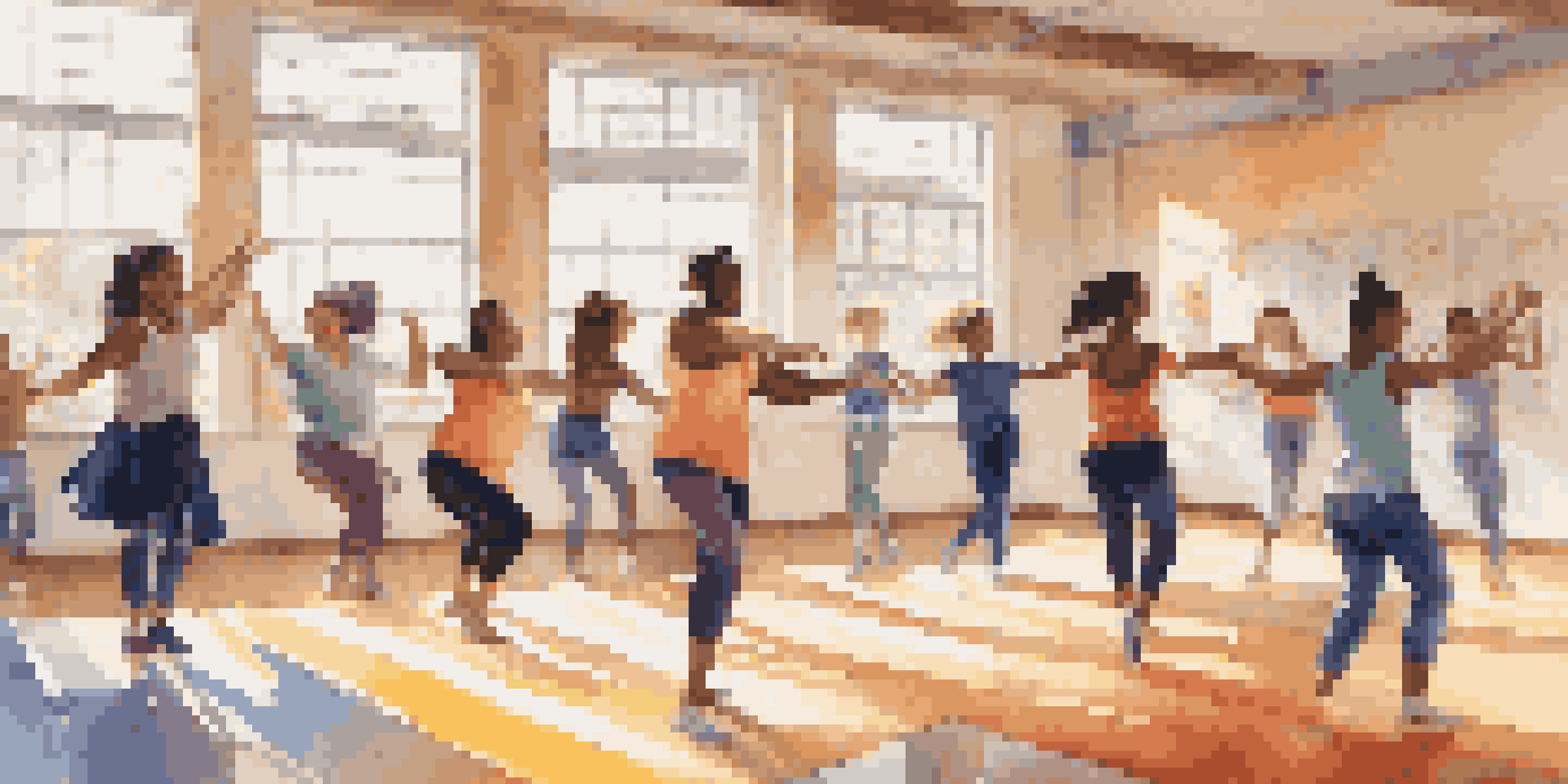The Impact of Dance on Mental Health and Well-Being in Schools

Understanding Dance as a Form of Expression in Schools
Dance offers students a unique way to express their thoughts and feelings. Through movement, they can communicate emotions that might be difficult to articulate with words. For many, this form of expression serves as a safe outlet for stress and anxiety, allowing them to process their experiences creatively.
Dance is the hidden language of the soul.
In a school environment, where academic pressures can be overwhelming, dance provides a refreshing break. It encourages students to take a step back from their studies and engage in a joyful activity. This balance is crucial for mental health, as it fosters a sense of community and belonging among peers.
Moreover, dance can also help students discover their identity. As they explore different styles and techniques, they gain confidence in their abilities, which can positively influence their self-esteem. This journey of self-discovery is essential during the often tumultuous school years.
The Connection Between Dance and Emotional Well-Being
Engaging in dance can significantly boost emotional well-being among students. Research shows that physical activity, like dance, releases endorphins, which are known as the body's natural mood lifters. When students dance, they not only enjoy the moment but also experience a chemical reaction that can improve their overall mood.

Additionally, dance can serve as a form of stress relief. The rhythmic movements encourage students to focus on the present, allowing them to momentarily forget about their worries. This mindfulness aspect of dance is particularly beneficial for young people facing academic and social pressures.
Dance Boosts Emotional Well-Being
Engaging in dance releases endorphins and fosters mindfulness, significantly improving students' emotional health.
Furthermore, participating in group dance activities fosters social connections. These interactions can help students build friendships and support networks, which are crucial for emotional resilience. Feeling connected to others can mitigate feelings of loneliness and depression, enhancing their mental well-being.
Building Confidence and Self-Esteem Through Dance
Dance is an excellent way for students to build confidence and self-esteem. When students learn new movements and perform them successfully, they experience a sense of accomplishment. This feeling can translate into other areas of their lives, encouraging them to take on new challenges with a positive mindset.
Dance is the joy of movement and the heart of life.
Moreover, dance often involves performing in front of an audience, which can be a powerful confidence booster. While it might seem daunting at first, successfully sharing their skills with others fosters a sense of pride. Over time, this experience of being in the spotlight can help students become more comfortable with public speaking and other social situations.
In addition to personal growth, dance also helps students appreciate their bodies. Through movement, they learn to respect and celebrate their physical abilities, fostering a positive body image. This appreciation is vital, especially in a world where young people often face unrealistic standards.
Creating a Supportive Community Through Dance Programs
Dance programs in schools often create a sense of community among students. When they participate in group classes or performances, they bond over shared experiences, which can lead to lasting friendships. This social aspect of dance is particularly important for students seeking connection in a diverse school environment.
Additionally, supportive dance instructors play a crucial role in fostering a positive atmosphere. A caring teacher can encourage students to express themselves freely, making them feel valued. This support can have a profound impact on students, as they learn to trust their creativity and instincts.
Dance Builds Confidence and Identity
Through learning and performing dance, students gain confidence and a positive body image, aiding their self-discovery.
Furthermore, school dance programs can promote inclusivity. By welcoming students of all skill levels and backgrounds, these programs can help break down social barriers. This inclusivity not only enhances the dance community but also contributes to a more accepting school culture overall.
Dance as a Tool for Stress Management in Schools
Incorporating dance into the school curriculum can serve as an effective stress management tool. Physical activity is known to reduce cortisol levels, the hormone associated with stress. By allowing students to engage in dance, schools can provide them with a healthy way to cope with their academic and personal pressures.
Moreover, dance allows for a release of pent-up energy and emotions. Instead of bottling up feelings, students can channel their frustrations into movement. This cathartic experience can be incredibly liberating, helping them feel more balanced and centered.
Additionally, regular dance classes can instill a sense of routine and discipline. As students commit to practice and improve their skills, they cultivate a sense of responsibility. This structured approach can alleviate anxiety, as they learn to manage their time and expectations effectively.
The Role of Dance in Enhancing Cognitive Function
Surprisingly, dance can also enhance cognitive function among students. Engaging in dance requires focus, coordination, and memory, all of which stimulate various parts of the brain. This mental engagement can lead to improved academic performance, as students learn to apply these skills in their studies.
Research suggests that physical activity, including dance, can boost brain health. Regular movement increases blood flow to the brain, which can enhance cognitive abilities like problem-solving and critical thinking. As students dance, they exercise not just their bodies but also their minds.
Dance Fosters Community and Inclusivity
School dance programs create a supportive environment that encourages friendships and breaks down social barriers.
Additionally, learning choreography can improve memory and concentration. The process of remembering steps and sequences helps sharpen cognitive skills, preparing students for complex tasks in and out of the classroom. This dual benefit of dance makes it a valuable addition to any school program.
Promoting Cultural Awareness and Appreciation Through Dance
Dance is a universal language that transcends cultural boundaries. By incorporating various dance styles into school programs, students can learn about different cultures and traditions. This exposure fosters appreciation and respect for diversity, enriching their social and emotional development.
Furthermore, cultural dance forms often tell stories and convey messages. By exploring these narratives, students gain insight into the values and beliefs of different communities. This understanding can promote empathy and compassion, key components of emotional intelligence.

Additionally, celebrating cultural dance through events or performances encourages community involvement. Families and local communities can come together to support students, creating a vibrant atmosphere of shared experiences. This connection to culture not only enhances students' learning but also strengthens community ties.